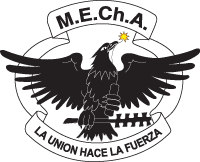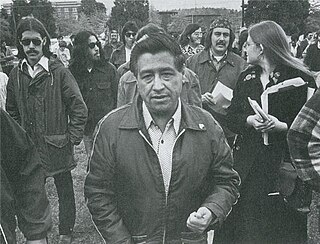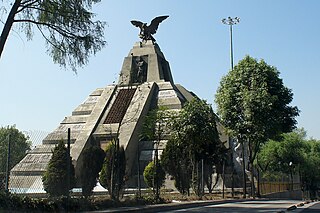Related Research Articles

Chicano, Chicana, is an identity for Mexican Americans who have a non-Anglo self-image. Chicano was originally a classist and racist slur used toward low-income Mexicans that was reclaimed in the 1940s among youth who belonged to the Pachuco and Pachuca subculture. In the 1960s, Chicano was widely reclaimed in the building of a movement toward political empowerment, ethnic solidarity, and pride in being of indigenous descent. Chicano developed its own meaning separate from Mexican American identity. Youth in barrios rejected cultural assimilation into whiteness and embraced their own identity and worldview as a form of empowerment and resistance. The community forged an independent political and cultural movement, sometimes working alongside the Black power movement.

M.E.Ch.A. is a US-based organization that seeks to promote Chicano unity and empowerment through political action. The acronym of the organization's name is the Chicano word mecha, which is the Chicano pronunciation of the English word match and therefore symbolic of a fire or spark; mecha in Spanish means fuse or wick. The motto of MEChA is 'La Union Hace La Fuerza'.
The Chicano Moratorium, formally known as the National Chicano Moratorium Committee Against The Vietnam War, was a movement of Chicano anti-war activists that built a broad-based coalition of Mexican-American groups to organize opposition to the Vietnam War. Led by activists from local colleges and members of the Brown Berets, a group with roots in the high school student movement that staged walkouts in 1968, the coalition peaked with a August 29, 1970 march in East Los Angeles that drew 30,000 demonstrators. The march was described by scholar Lorena Oropeza as "one of the largest assemblages of Mexican Americans ever." It was the largest anti-war action taken by any single ethnic group in the USA. It was second in size only to the massive U.S. immigration reform protests of 2006.

The Brown Berets is a pro-Chicano paramilitary organization that emerged during the Chicano Movement in the late 1960s. David Sanchez and Carlos Montes co-founded the group modeled after the Black Panther Party. The Brown Berets was part of the Third World Liberation Front. It worked for educational reform, farmworkers' rights, and against police brutality and the Vietnam War. It also sought to separate the American Southwest from the control of the United States government.

Chicanismo emerged as the cultural consciousness behind the Chicano Movement. The central aspect of Chicanismo is the identification of Chicanos with their Indigenous American roots to create an affinity with the notion that they are native to the land rather than immigrants. Chicanismo brought a new sense of nationalism for Chicanos that extended the notion of family to all Chicano people. Barrios, or working-class neighborhoods, became the cultural hubs for the people. It created a symbolic connection to the ancestral ties of Mesoamerica and the Nahuatl language through the situating of Aztlán, the ancestral home of the Aztecs, in the southwestern United States. Chicanismo also rejected Americanization and assimilation as a form of cultural destruction of the Chicano people, fostering notions of Brown Pride. Xicanisma has been referred to as an extension of Chicanismo.

The Chicano Movement, also referred to as El Movimiento, was a social and political movement in the United States inspired by prior acts of resistance among people of Mexican descent, especially of Pachucos in the 1940s and 1950s, and the Black Power movement, that worked to embrace a Chicano/a identity and worldview that combated structural racism, encouraged cultural revitalization, and achieved community empowerment by rejecting assimilation. Before this, Chicano/a had been a term of derision, adopted by some Pachucos as an expression of defiance to Anglo-American society. With the rise of Chicanismo, Chicano/a became a reclaimed term in the 1960s and 1970s, used to express political autonomy, ethnic and cultural solidarity, and pride in being of Indigenous descent, diverging from the assimilationist Mexican-American identity. Chicanos also expressed solidarity and defined their culture through the development of Chicano art during El Movimiento, and stood firm in preserving their religion.

Chicana feminism is a sociopolitical movement, theory, and praxis that scrutinizes the historical, cultural, spiritual, educational, and economic intersections impacting Chicanas and the Chicana/o community in the United States. Chicana feminism empowers women to challenge institutionalized social norms and regards anyone a feminist who fights for the end of women's oppression in the community.

The East Los Angeles Walkouts or Chicano Blowouts were a series of 1968 protests by Chicano students against unequal conditions in Los Angeles Unified School District high schools. The first walkout occurred on March 5, 1968. The students who organized and carried out the protests were primarily concerned with the quality of their education. This movement, which involved thousands of students in the Los Angeles area, was identified as "the first major mass protest against racism undertaken by Mexican-Americans in the history of the United States."

The Spanish expression la Raza has historically been used to refer to the Hispanophone populations, considered as an ethnic or racial unit historically deriving from the Spanish Empire, and the process of racial intermixing of the Spanish colonizers with the indigenous populations of the Americas.

Partido Nacional de La Raza Unida is a former Hispanic political party centered on Chicano (Mexican-American) nationalism. It was created in 1970 and became prominent throughout Texas and Southern California. It was started to combat growing inequality and dissatisfaction with the Democratic Party that was typically supported by Mexican-American voters. After its establishment in Texas, the party launched electoral campaigns in Colorado, Arizona, New Mexico, and California, though it only secured official party status for statewide races in Texas. It did poorly in the 1978 Texas elections and dissolved when leaders and members dropped out.

Chicano poetry is a subgenre of Chicano literature that stems from the cultural consciousness developed in the Chicano Movement. Chicano poetry has its roots in the reclamation of Chicana/o as an identity of empowerment rather than denigration. As a literary field, Chicano poetry emerged in the 1960s and formed its own independent literary current and voice.

Chicana literature is a form of literature that has emerged from the Chicana Feminist movement. It aims to redefine Chicana archetypes in an effort to provide positive models for Chicanas. Chicana writers redefine their relationships with what Gloria Anzaldúa has called "Las Tres Madres" of Mexican culture by depicting them as feminist sources of strength and compassion.

The Chicano Art Movement represents groundbreaking movements by Mexican-American artists to establish a unique artistic identity in the United States. Much of the art and the artists creating Chicano Art were heavily influenced by Chicano Movement which began in the 1960s.
A Mexican American is a resident of the United States who is of Mexican descent. Mexican American-related topics include the following:
Rita Martinez was a Chicana activist operating in Pueblo, Colorado. She is notable for her activism against the observance of Columbus Day in Colorado. Her efforts came to fruition in 2020, when Colorado Governor Jared Polis signed a bill abolishing Columbus Day.
Deborah Mora Espinosa is a Chicana activist in Colorado. She worked for History Colorado as the director of El Pueblo History Museum.
Plaza Verde Park is a park established in 1972 in Pueblo, Colorado.
Martín Porferio "Marty" Serna was an early organizer of the Chicano Movement, who was one of the founders of the Brown Berets in Pueblo, Colorado. He was part of the La Raza Unida political party, and developed several community organizations in Pueblo including the Black/Brown Berets, United Farmworkers Organization, Escuela Huitzhualopán, Southern Colorado Chicano Planning Council, and El Partido de la Raza Unida.
La Cucaracha (1976-1983) was an English and Spanish bilingual newspaper created by and for the Chicano community of Pueblo, Colorado. Creators Juan Espinosa, Deborah Espinosa, David Martinez and Pablo Mora recognized the exclusion of Chicanos in popular media and published the first issue in 1976.
Carmen Roybal Arteaga is a Pueblo-based activist for Chicano education and historical research. She has been an advocate for bilingual and bicultural education in Pueblo schools to meet the needs of the large Chicano population. She was also known as Carmen Serna when she was married to activist Martín Serna.
References
- 1 2 3 4 5 Tucker, Jeff (Jan 15, 2016). "Mothers led way on youth recreation, education". Pueblo Chieftain. Retrieved 31 October 2022.
- ↑ Strescino, Peter (May 5, 2003). "Cinco de Mayo". Pueblo Chieftain.
- ↑ History Colorado (2015). "El Movimiento: The Chicano Movement in Colorado" (PDF). History Colorado. Retrieved 31 October 2022.
- ↑ "Justicia para los Estudiantes". Vol. 6, no. 6. El Gallo. October 1, 1974.
- 1 2 3 "Plaza Verde Park". Pueblo Parks and Recreation. No. 2017-2018 Fall/Winter/Spring Program Guide. Pueblo Parks and Recreation. Retrieved 31 October 2022.